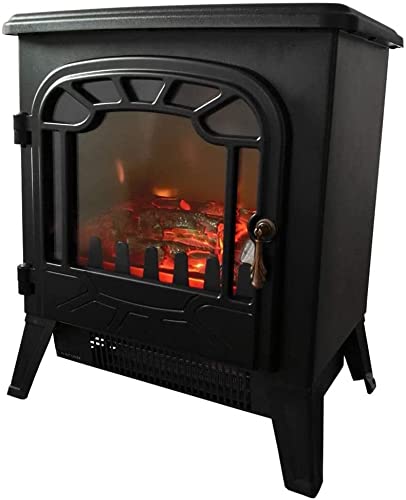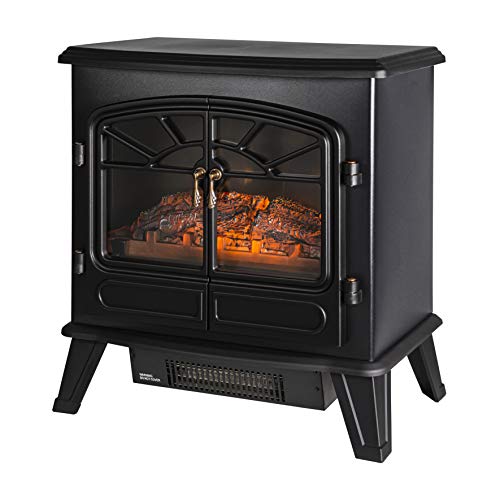Will Electric Heater Ever Be The King Of The World?
페이지 정보
작성자 Angelica Westbr… 댓글 0건 조회 11회 작성일 24-09-09 05:14본문
 What You Need to Know About an mini electric stove fire Heater
What You Need to Know About an mini electric stove fire HeaterElectric heaters are a great way to give a quick burst of warmth whenever you need it. They are typically classified based on the size of the room and have features such as thermostats, overheat switches, and timers.
An electric heater converts electrical energy into heat through heating in joules. The heating element is comprised of ceramic insulators and nichrome wire.
Resistor
The resistor is a component of the electrical circuit that hinders the flow of current within circuits by decreasing its voltage and absorbing some of it as heat. It converts electrical energy into thermal energy, and uses only a fraction of one watt. This is a common method used in electric light bulbs as well as heating elements.
The resistance of the resistor is determined by its thickness, material and other properties. The greater the resistance of the resistor, the more energy will be lost. This is because higher currents lead to more electrons inside the resistor, and more electrons mean more collisions between them. The more collisions that occur, the greater the temperature.
Resistors have a maximum power rating they are able to safely dissipate. This usually ranges between 1/8W (0.125W), and 1W. Resistors with a higher power rating can be identified by their larger packaging. The maximum power rating of a resistor can be determined from the packaging it comes in or by comparing its physical dimension to other resistors with a known power rating.
Electric Fireplace Stove Heater heaters are special types of power resistors that are designed to convert electrical energy into warmth. They can produce convective or radiant heating by emitting infrared rays. They are typically used in conjunction with fans to improve the efficiency of heating.
If the power rating of a resistor is exceeded, the resistor will become hot and may damage adjacent components. In extreme situations, the resistor may get to a point at which it self-ignites causing an explosion. To prevent this, it is recommended that a resistor be installed to limit the current.
Heater resistors come with a color code that indicates their value and other data like manufacturing accuracy and temperature coefficient. For example, a six-banded resistor will have five bands that tell you its digits, and then the sixth band will tell you its multiplier and tolerance. There are a variety of online calculators that you can use to calculate the value of your own resistor.
Coil
free standing log effect electric fires heating coils are the core of any electrically powered appliance that makes use of heat to warm objects or liquids. They use a process known as conduction to convert electricity into heat. They can be made in a variety of shapes based on their application. Heating coils made of electric are capable of generating a significant amount of heat in a short time, making them suitable for applications that require quick temperature changes or high levels of thermal efficiency.
The core of an electric heating coil is an intricately wound structure made composed of metal wires. This structure is tightly packed, allowing the largest number of wires to be contained in the smallest space, thereby increasing conductivity. The coil is then insulated using various different materials, depending on the needs of the specific application. For instance, the insulation of an electric heater used for liquid immersion could be made of non-flammable materials like polyvinyl chloride (PVC) or polyester or polyimide. A coil used for cryogenic applications is usually insulated with molybdenum disilicide.
In addition to protecting against elements, these materials also offer resistance to corrosion and oxidation, making them ideal for a wide range of industrial applications. Stainless steel is the most common element for a heater coil, but nickel-chrome and iron-chromium-aluminum alloys are also commonly used. These alloys offer a great combination of cost, corrosion resistance and oxidation resistance.
Because the metals inside the heating coil are exposed to corrosive and high-temperature environments, they need to be protected from damage. This protection includes sealants and coatings, improved drainage and ventilation, regular maintenance and inspections. Moisture ingress is a different problem that must be addressed since it can harm the internal components of a heater, and reduce its life expectancy.
Coils can also be used in other devices, like ovens, water tanks, and furnaces. They can be shaped in various shapes based on the intended use and are typically printed on substrates such as aluminum 6061-T6, mica sheets (muscovite, phlogopite or muscovite) or conductive plastic. They can be coated in a variety of materials, including nickel, silver and gold, to improve their appearance.
Thermostat
Although you may not think about it often your thermostat is a very important element of your home's comfort system. The thermostat's main function is to turn the heater on and OFF so that it maintains the temperature you prefer. It also allows you to adjust the temperature to suit your routine. This is great for those with an unpredictable schedule.
The most common type of thermostat is the electronic digital model which you can program with the smartphone app or a computer interface. Certain models have the ability to learn and adapt to your needs. You'll never again have to wonder when you should be home to eat dinner.
In the older thermostats that weren't digital the electrical circuit was controlled by a bimetal coil or metal band which would expand or shrink depending on the temperature. As the strip grew or contracted, it activated the mercury switch to tip, which activated the relay that turned on the heating system. Then, as the strip was cooling, it bent back and snapped away from its initial position, which turned off the heating.
Modern electronic thermostats have replaced electromechanical thermostats with a more precise technology that uses a temperature sensor and small electric stove heater relays to perform the same job. It's easy to understand the mechanics of an electromechanical thermostat by examining its components.
A thermometer coil with mercury in it is among the most crucial components. When you turn the lever of the thermostat up or down, it rotates the coil, which then tilts the mercury switch in one direction or the other. If the switch tips to the left, current flows through it and activates a relay that switches on the heater.
As the room heats, the mercury switches to the right, which breaks the circuit. The heater then shuts down. As the room cools down, the mercury returns to its initial position and the heater turns on again. If you continue to change the temperature of your electric thermostat, it could require overtime to keep up with your evolving preferences, which can cause it to consume more energy than it has to.
Timer
A wall heater timer allows you to program your lighting and heating. In contrast to traditional manual timers it has a built-in clock that will automatically turn on and turn off your lights or heaters according to the time set. It also helps you save money on your daily energy costs by avoiding excessive use.
They are most commonly used in the home however, they can also be found at industrial and commercial facilities. They provide convenience, energy efficiency and security by controlling the time that electric stove fireplace circuits are turned on and off. They can be connected to appliances such as water pumps, lights and ovens. They are a great option for those who wish to control electrical appliances without the use of computers or complicated programming.
The plug of a timer switch onto an extension cord or outlet will allow you to set it to set. Plug in the appliance that you wish to control. Depending on the model you can connect multiple devices at a time. Some models have a plug in the center of the timer, while others have a socket on the side or below it. You can pick from a variety of plug-in timer switches, such as those which can be controlled using a smartphone or tablet.
 Most mechanical timers feature a dial with hour and half-hour marks. You can also use the teeth to set an "ON" and "OFF" time. You can find models that have multiple sets. This allows you to set the time for various days. Be aware that mechanical timers might not always work correctly, especially if their internal clock is slightly off. If your timer doesn't turn on or off when it is supposed to be, look over the wiring for any errors and make sure that all pins are correctly inserted. If you can't fix the issue, it's suggested to contact a professional. You may also try replacing the timer. It is recommended to keep the timer safe away from pets and children.
Most mechanical timers feature a dial with hour and half-hour marks. You can also use the teeth to set an "ON" and "OFF" time. You can find models that have multiple sets. This allows you to set the time for various days. Be aware that mechanical timers might not always work correctly, especially if their internal clock is slightly off. If your timer doesn't turn on or off when it is supposed to be, look over the wiring for any errors and make sure that all pins are correctly inserted. If you can't fix the issue, it's suggested to contact a professional. You may also try replacing the timer. It is recommended to keep the timer safe away from pets and children.댓글목록
등록된 댓글이 없습니다.